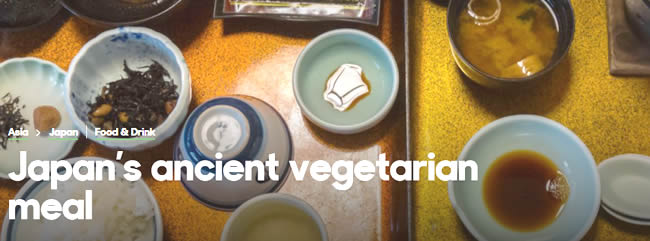先日から「Japan’s ancient vegetarian meal -「日本古来の菜食料理」を読んでいます。

・「日本古来の菜食料理」(1)
・「日本古来の菜食料理」(2)
Dogen’s famed essay, “Tenzo Kyokun”, meaning “Instructions to the Cook”, outlines not only the importance of ingredient selection and balance, but the mindfulness of the chef.
道元の著名な随筆「典座教訓(てんぞきょうくん)」は“料理人への指導”という意味で、食材の選択とバランスの重要性だけでなく、調理人の精進についても概説している。
mindfulness「今この瞬間の自身の精神状態に深く意識を向けること、またそのための瞑想」。
The simple dish of goma dofu (sesame tofu) – which requires hours of grinding and stirring – is a well-known example, with the repetitive process demanding a single-minded focus from the chef.
シンプルな胡麻豆腐 – 何時間も胡麻を挽いてかき混ぜる必要がある – はそのよく知られた例であり、繰り返しの工程は調理人にひたむきな集中を要求する。
single-minded「(一つの目的に)ひたむきの、一意専心の」。
Given the lengthy, labour-intensive process and the comparatively brief moment it takes to eat,
長くて労働集約的な調理工程と比較的短い食事の瞬間を考えると、
Shiten considered it the essence of shōjin cuisine, and a lesson in balancing the expectations of the ego.
シテン氏はそれこそが精進料理の本質であり、自我の期待とのバランスをとる教えであると考えた。
Shōjin chefs are required to possess the three minds of Japanese Zen Buddhism, known as sanshin, and they become as much a part of the meal as their ingredients.
精進料理の調理人は、三心(さんしん)と呼ばれる日本の禅仏教の3つの精神を忘れてはならず、それらは食材と同じように食事の一部となる。
Daishin (the big mind) must be maintained for calmness and motivation;
大心(大きな心)は落ち着きとやる気を維持する心、
roshin (the parental mind) is needed to respect and care for the ingredients and diner;
老心(親の心)は、食材や食べる人を尊重しもてなすために必要な心、
while kishin (the precious mind) requires the cook to work with pleasure and gratitude.
一方、喜心(喜びの心)は、調理人が喜びと感謝の気持ちを持って働く心だ。
mindfulness を「精進(雑念を捨て仏道修行に専心すること・一つのことに精神を集中して励む事)」とするのが適切かどうか迷いますが、遠くもないかなと思いました。
GAFAでマインドフルネス瞑想を取り入れているという話は有名ですが、あれも自分の内側に集中する術と考えると、日本語の「精進」の要素も含まれるかな?という気がします。
知らないことばかりで、色々と意味を考え悩む記事であります(笑)。
理由は単純明快!「少ないコストでしっかり楽しく学べるから」。
私自身の経験(高機能でビックリ)をびっしり書いていますので、良かったら読んでみてください。
下のバナーからどうぞ!






